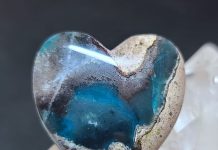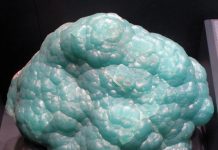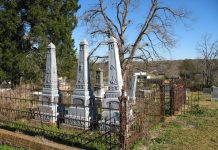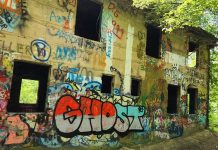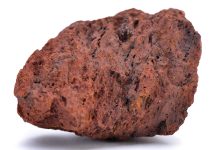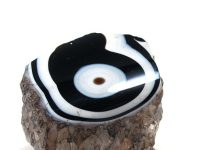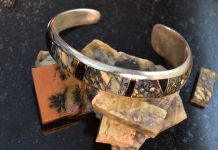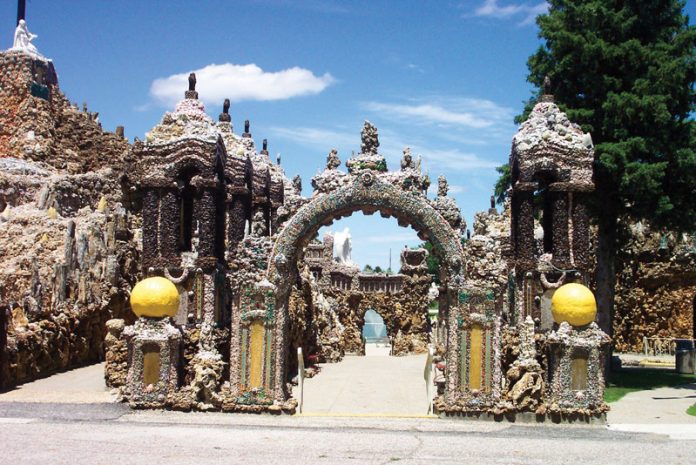
The Shrine of the Grotto of the Redemption, nestled in the heart of the northern Iowa town of West Bend, is the largest manmade grotto in the world and is regarded as the world’s most complete assemblage of minerals, fossils, shells, and petrifications in one location. It was the brainchild of Father Paul Matthias Dobberstein (1872-1954), a German-American priest, architect, and arguably, self-taught geologist.

His creation even caught the attention of Walt Disney who wanted to construct a replica of the grotto for Disneyland but was told by his engineering consultants that the structure was a “once in a lifetime” piece that couldn’t be matched.
What Materials Were Used to Make the Grotto?
Approximately the size of a metropolitan city block, the Shrine of the Grotto of the Redemption — which consists of nine grottos — is owned by the Roman Catholic Diocese of Sioux City, and is located 130 miles northwest of Des Moines. It was placed on the National Register of Historic Places in 2001.
The Shrine of the Grotto of the Redemption is crafted out of metamorphic, sedimentary, and igneous rocks with marble statues, replete with the following: polished agate, azurite, fluorite, malachite, druzy quartz, petrified wood, fossils, corals, shells, pink quartz, jasper, topaz, amethyst, calcite, pudding stone, marble, and geodes. You can even spot mudball formations taken from the Cannonball River in North Dakota. Twenty-three karat gold leaf peppers the premises.
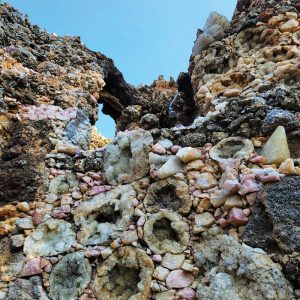
The grotto, located entirely outdoors, is open 24 hours a day and no admission fee is charged. It was designed, constructed, and is maintained today solely through donations.
Andy Milam, the grotto’s curator, explained the site was not completed upon Father Dobberstein’s death, but rather, the existing structures are preserved and maintained.
The grotto illustrates the story of Christ’s Redemption of man, from the Fall to the Resurrection. It has 26 religious stations with 65 statues of Carrara marble carved by Italian sculptors.
Dobberstein’s Vision
Dobberstein, who was born in Rosenfeld, Germany, on September 21, 1872, came to America when he was 20 years old and entered the Seminary of St. Francis near Milwaukee. He was ordained on June 30, 1897. The following year, he became the pastor of Sts. Peter and Paul Catholic Church in West Bend, Iowa, served there until his death on July 24, 1954.
It was during his time studying for the priesthood that he fell critically ill with pneumonia. “He prayed to the Blessed Virgin and said, ‘If I’m healed, I’m going to build you a shrine,’” Milam said. “He got better, and remembered what the natural grottos and niche caves were like in Germany, so he built one here for her, starting in 1912.”
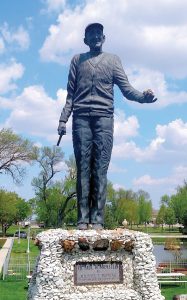
Building the Shrine of the Grotto of the Redemption
The grotto was built on swampland with a team of two horses used to dig out a pond. From there, the pond was drained, revealing a layer of clay about 15 feet below ground. The foundation was built from Fieldstone and does slope a bit.
The priest began his efforts by searching for Iowa-sourced rocks before branching out globally. Geodes, the state rock of Iowa, are prominent throughout.
Wishing wells on the grounds were set up to collect monetary contributions to fund Dobberstein’s travel expenses to secure the materials. Milam added that at one time, the priest’s garage was filled with donated coins. Some of the more rare specimens include a 300-pound amethyst, Belgian agates, and a rock Dobberstein invented during the Great Depression.
“He would go to the school, collect the used crayons and melt them down using a smelting machine,” Milam said. “We call it Dobberstein rock.”
In the foreword of the booklet “An Explanation of the Grotto of the Redemption,” Dobberstein wrote: “Spoken words are ephemeral; written words remain, but their durability depends upon the material on which they are written. If carved in stone or sculpted in bronze, words are well nigh imperishable. This imperishableness is an outstanding feature of the Grotto. Thus the Grotto of the Redemption will continue to tell its story long after the builder has laid down his trowel, and will be a silent sermon expressing in permanently enduring precious stones, the fundamental truths of Christianity.” Parishioner Matthew Szerensce who continued work on the grotto after Dobberstein’s death aided him in his efforts. Construction was done by hand, using horses, buckets, and wheelbarrows. In 1947, when approximately 80 percent of the project was finished, an electric hoist was installed. Rock hammers were swapped for air hammers.
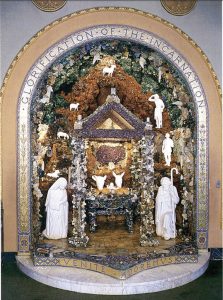
Father Louis Greving and the Shrine of the Grotto of the Redemption
Father Louis Greving arrived in 1946 and assisted Dobberstein in his parish duties, as well as work on the grotto.
“Although Father Dobberstein had no formal blueprints of the various grottoes, he talked about his plan frequently,” he wrote. In ailing health, he placed his trust in Greving and Szerensce to finish any work that had been started. Dobberstein died on July 24, 1954, and is buried in the parish cemetery one-half mile west of the grotto. Greving took up the torch for the cause of caring for the grotto.
“By providence of God I spent my priesthood of some 45 years (since 1946) in the shadow of the Grotto of the Redemption. The Grotto is a monument of faith, hope and love that once lived in the mind and heart of Father Paul Dobberstein,” said Greving. His championing of the grotto helped it secure National Register of Historic Places designation in 2001. He died in 2002 at the age of 81.
The nine grottos depict the following scenes.
1. Garden of Eden – Adam and Eve eat the forbidden fruit and are cast out.
2. Stable of Bethlehem – The Divine Child is born. (Completed after Dobberstein’s death).
3. Home in Nazareth – Jesus’ boyhood home and humble beginnings are depicted. (Completed after Dobberstein’s death).
4. Trinity – One God in three Persons is symbolized in three half circles.
5. Ten Commandments – Man is told to keep the Commandments to gain eternal life.
6. Gethsemane – Christ is shown praying and suffering on eve of the crucifixion.
7. Stations of the Cross – Christ is degraded, crucified and dies for all.
8. Fourteenth Station – Christ is buried.
9. Resurrection – Christ is not here, in the grave; He has risen.
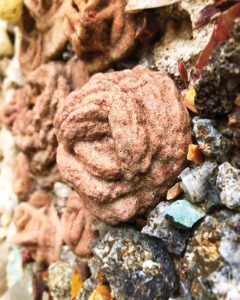
How Were Stalactites Grown at the Grotto?
Dobberstein grew stalactites in the ceiling of the Grotto of the Ten Commandments. When he built that grotto, he had also put in a deposit of calcium and magnesium in the ceiling. He left a six-inch hole in the roof so whenever it rains, water collects there and gradually seeps through. In time, the mineral-saturated water drips through the ceiling and forms the stalactites.
The Christmas Chapel in the church was built in 1927. It’s made of materials from every state and nearly every country. The large Brazilian amethyst in the background of the chapel weighs 300 pounds. The agates in the base of this structure were cut and polished in Belgium.
Above the Beatitudes is a monumental stalagmite from Carlsbad Caverns in New Mexico. It was donated to the grotto by Jim White, the man who first developed the cave before the site became a national park.
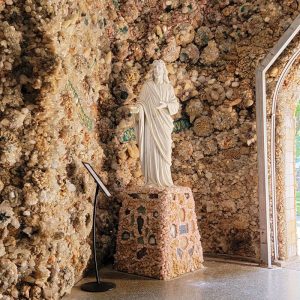
How is the Shrine of the Grotto of the Redemption Maintained?
Dobberstein made sure to cure cement used for construction. According to information obtained from the forms filed for historic designation: “Once the concrete was hard enough to hold the rocks in place, he would sprinkle water over the concrete every four or five hours for one week. This curing process keeps the chemical reaction in operation while the concrete sets up. Consequently, the concrete bonds together into a solid mass.”
The Shrine of the Grotto of the Redemption was never completed because his successors didn’t know how he’d intended to cap off his tribute to the Virgin Mary.
Two to three times a year it is hosed down to flush out any debris. Rain also helps with this process. Loose rocks are repaired. Iowa winters (the freezing and thawing) are the grotto’s biggest enemy, Milam explained.
Visitors are welcome to stay for as long as they’d like and to view the grotto during different times of the year, as well as daytime and at night.
“He really never quit (building the shrine) for the next 47 years. He kept adding grottos, a courtyard, Stations of the Cross and spent months upon months looking for rocks, having them sent to him, working with collectors and rock hounds, people with farm fields full of rocks,” Milam added.
“One of the hallmarks of the Catholic Church is we don’t do things in just a utilitarian way: there’s always a sense of beauty to everything that’s done within the life of the church, so this was his way of carrying that out.”
What Other Projects Were Built By Father Dobberstein?
The Stations of the Cross are being worked on by Marion Restoration out of Chicago, which Milam says is a six-figure project, all funded through donations and purchases from the gift shop.
Every year, the Shrine of the Grotto of the Redemption is visited by tens of thousands of visitors. It is also equipped with 53 campsites. Guided tours are offered.
Perhaps it was Father Dobberstein who best explained the rationale behind his decades-long mission to build the grotto, during a conversation with Greving. “God is the master artist. Look at those flowers. There is a beauty, a symmetry, in every petal.
All the colors blend harmoniously. It is pleasing to the eye. All that any human artist can do is to imitate God’s artistry, and it is a poor imitation at best.”
In addition to the Shrine of the Grotto of the Redemption at West Bend, Father Dobberstein built six other smaller grottos or memorials at these locations:
1. Sacred Heart Church: Sioux City, Iowa
2. Immaculate Conception Grotto: Carroll, Iowa (now gone)
3. Franciscan Convent: Dubuque, Iowa
4. Shrine in the St. Rose of Viterbo Convent of the Franciscan Sisters of Perpetual Adoration: La Crosse, Wisconsin (now gone)
5. Catholic Cemetery: Wesley, Iowa
6. John Brown Park: Humboldt, Iowa
This story about the Shrine of the Grotto of Redemption previously appeared in Rock & Gem magazine. Click here to subscribe. Story by Sara Jordan-Heintz.


